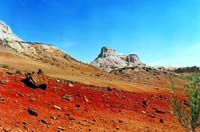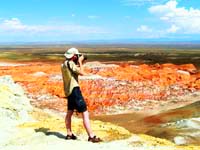Kiin-Kirish Canyon
Kazakhstan - Kiin-Kirish Valley. Deserts of Kazakhstan
Among barren valleys, the walls and turrets of ancient towns and castles rise into the sky. It is not a mirage, it is Kiin-Kerish (Proud Beauty), a natural aeolian town also called "Town of Spirits". Built from tertiary clays, it is an unimaginably beautiful place with unique red, white and orange buildings. In the distance, the bright clay cliffs and abysses of Kiin-Kerish resemble a flame wavering in the wind.
Therefore these cliffs are called "Glowing Rocks". The main treasures of Kiin-Kerish are small layers of clay and sand with fossils from the tropical past of this place (palms, magnolias, araucaria, and others) and remnants of vertebrates (rhinoceros, crocodiles, turtles and salamanders).
Kiin-Kerish - a colored clay canyon, is situated 120 km from the town of Kurchum (2 hours' journey).
Road - partially paved, in bad condition, driving speed is 50-60 km/h and 15 km on unpaved sections.
Landscape: steppe, bands of meadows near the dry channels of streams, disappearing in summer. In the midst of these desert plains Kiin-Kerish sits - a landscape object, composed of tertiary clays, unimaginable in beauty and originality, with unique red, white and orange buildings, which resemble towers, walls of castles, and domes of minarets. From afar the bright clay rocks and cliffs resemble flames waving in the wind. Due to this fact, they are called the "Flaming Rocks". Heat, prevailing here, and the complete absence of water create fantastic images and a peculiar mystical atmosphere.

Flora and fauna of this place are unique. Aside from saxaul, the flora is represented by two rare species of plants, recommended for protection at the regional level: Krylov's ferule (Ferula krylovii Korov.) and atraphaxis greyish (Atraphaxis canescens Bunge).
Kiin-Kerish, along with its surroundings, is one of the places in the Zaisan hollow where rare species of animals concentrate. Among the mammals included in the Kazakhstan Red Book, the yellow lemming (Lagurus luteus Eversm.) lives here. This animal is of much scientific interest as a species that is on the verge of extinction in the contemporary geological period. During periods of high population it serves as a basic meal for predatory mammals and birds, including species that are in the Red Book.
On the clay cliffs of Kiin-Kerisha the following birds build their nests - the eagle-owl (Bubo bubo L.), Baloban (Falco cherrug J.E. Gray), and steppe eagle (Aqulia nipalensis Hogs), listed in the Kazakhstan Red Book. Apart from these, the golden eagle (Aquilia chysaetos L.), (Pterocles orientalis L.), (Syrrhaptes paradoxus Pall.) and rarely jack (Chlamydotis undlata Jacquin) are found here.
Among the birds recommended for protection at the regional level, the steppe kestrel (Cerchneis naumanni Flesch.), (Buteo rufinus Cretzschm), and Central Asian buzzard (Buteo hemilasius Swinh.) nest in the cliffs of Kiin-Kerish.

The landscapes of the nearby region of Northern Zaisan are of loose rock and pebbles, clay and brackish deserts. Landscape diversity is one of the peculiarities of Asia's northern deserts peculiarities.
The inaccessibility of this place has accidentally preserved these landscapes in their original primeval condition, due to the fact that there is almost no economic activity here.
Some interesting plants can be found here, such as the heterophyllous poplar (Populus diversifolia), Zaisan globe-thistle (Echinops zaissanicus), a South Altaian endemic wormwood (Artemidia), saltwort (Chenopodiacea), elms (Caragana arborescens), irises (Iridaceae), and tulips (Tulipa).
At the southern end of the Altai foothills the following species can be found: (Alektoris kakelik), partridge (Perdix perdix), steppe eagle (Aquila rapax), (Aquila helica), (Buteo rufinus), rough-legged buzzard (Buteo hemylasius), steppe kestrel (Falco tinnunculus), (Falco cherrug), wheat-ears (Oenanthe oenanthe, O. pleshanka), bunting: rocky, red-eared, hilly, yellow (Emberiza buchanani, E. cioides, E. cia, E. bruniceps), larks - field, steppe (Alauda arvensis, Melanocorypha calandra), horned (Eremophila alpestris), and motley stone thrush (Monticola zaxatilis). Many kinds of birds nest here at the southern and northern ends of their natural habitats.
Moving on (about 20 km) to Barhot cape and Baklaniy cape (near Shekelmes mountain), driving on an unpaved road. Narrow sandy strips, 100 - 200 meters wide, stretch to the center of the lake for 3 - 3.5 km. You can see here flocks of pelicans and cormorants, resting on the sandy beaches. Sunsets are extremely beautiful; they color the lake and surrounding desert landscape in bright hues: orange, yellow, and red. Night with its huge stars in the black sky, warm winds, saturated with the rough smells of desert grass, the noise of the waves - all this makes a great impression on travelers.
